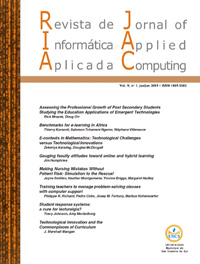Student response systems: a cure for lecturalgia?
DOI:
https://doi.org/10.13037/ria.vol5n1.379Keywords:
Interactive Teaching Techniques, Lecture, MotivationAbstract
The most frequent cause of lecturalgia (painful lecture) is students' inability to maintain attention (McLauglin and Mandin, 2001). In order to address this problem many universities have turned to the student response system (SRS) to facilitate student interaction. The most frequently reported benefits of a SRS are that students perceive lectures to be more interactive, engaging, and enjoyable. However, little research has been conducted with large sections of education students. The general motivation for this study was to determine whether the ailment of lecturalgia can be cured by using SRS to facilitate increased interaction and engagement in large lecture classes of pre-service teachers. The results support previous findings. In addition, for instructors who are already using interactive teaching techniques, this study suggests that the use of a SRS offers greater efficiency and accuracy.Downloads
References
ASTIN, A. W. (1993). What matters in college? Four critical years revisited (San Francisco, CA, Jossey-Bass).
BLIGH, D.A. (2000). What's the Use of Lectures? San Francisco: Jossey-Bass.
BOYLE, J. T., & NICOL, D. J. (2003). Using classroom communication systems to support interaction and discussion in large class settings. Association for Learning Technology Journal, 11(1), 43-57.
BRUNER, J. S. (1961). The act of discovery. Harvard Educational Review, 31(1), 21-32.
BUNCE, D. M., VAN DEN PLAS, J. R., and Havanki, K. L. (2006). Comparing the effectiveness on student achievement of a student response system versus online WebCT quizzes. Journal of Chemical Education, 83(3), 488-493.
BURNSTEIN, R. A., and LEDERMAN, L. M. (2001). Using wireless keypads in lecture classes. The Physics Teacher, 39(1), 8-11.
CLARK, R.E. & SUGRUE, B.M. (1991). Research on instructional media, 1978-1988. In G.J.Anglin (Ed.) Instructional technology: past, present, and future (pp.327-343). Colorado: Libraries unlimited: Englewood.
CUTTS, Q., KENNEDY, G., MITCHELL, C., AND DRAPER, S. (2004). Maximizing Dialogue in Lectures Using Group Response Systems. International Conference Computers and Advanced Technology in Education, 2004, International Association of Science and Technology for Development, Kauai, Hawaii. 421-426.
DRAPER, S.W., & BROWN, M.I. (2004). Increasing interactivity in lectures using an electronic voting system. Journal of Computer Assisted Learning, 20, 81-94.
DRAPER, S., CARGILL, J., and CUTTS, Q. (2002). Electronically enhanced classroom interaction. Australian Journal of Educational Technology, 18(1), 13-23.
ELLIOT, C. (2003). Using a personal response system in economics teaching. International Review of Economics Education, 1(1), 80-86.
FIES, C. & MARSHALL, J. (2006). Classroom Response Systems: A Review of the Literature, Journal of Science Education and Technology, 15(1), 101-109.
GAGNE, R. (1985). The Conditions of Learning (4th ed.). New York: Holt, Rinehart & Winston.
GRAHAM C., TRIPP, T., SEAWRIGHT, L., & JOECKELIII, G. (2007). Empowering or compelling reluctant participators using audience response systems, Active Learning in Higher Education, 8(3), 233-258.
HAKE, R., (1998). Interactive engagement vs. traditional methods: A six-thousand-student survey of mechanics test data for introductory physics courses, American Journal of Physics, 66(1), 64-74.
HALLORAN, L. (1995). A comparison of two methods of teaching: computer managed instruction and keypad questions versus traditional classroom lecture. Computers in Nursing, 13(6), 285-288.
HAVILL, D. (2007). Piloting a Personal Response System at an Arabic University. World Conference on Educational Multimedia, Hypermedia and Telecommunications 2007. Association for the Advancement of Computing in Education. Chesapeake, VA. 2219-2228.
MAYO, E. (1977). The Human Problems of an Industrial Civilization, New York: Arno Press, 55-98.
McLAUGLIN, K. and MANDIN, H. (2001). A schematic approach to diagnosing and resolving lecturalgia, Medical Education 35(1),1135-1142.
PASCHAL, C. B. (2002). Formative assessment in physiology teaching using a wireless classroom communication system. Advances in Physiology Education, 26(1), 299-308.
POULIS, J., MASSEN, C., ROBENS, E., & GILBERT, M. (1998). Physics lecturing with audience paced feedback. American Journal of Physics, 66(5), 439-441.
ROSCHELLE, J., PENUEL, W. R., and ABRAHAMSON, L. (2004). The networked classroom. Educational Leadership, 61(5), 50-54.
SCHEELE, N., WESSELS, A., EFFELSBERG, W., HOFER, M., & FRIES, S. (2005). Experiences with interactive lectures - considerations from the perspective of Educational Psychology and Computer Science. International Conference on Computer Supported Collaborative Learning, 2005, The International Society of the Learning Sciences, Taipei, Taiwan. 547-556.
SMITH, B. (2001). Just give us the right answer. In H. Edwards, B. Smith, & G. Webb (Eds.). Lecturing. Case studies, experience and practice (pp. 123-129). London: Kogan.
TREES, APRIL R. and JACKSON, MICHELE H. (2007). The learning environment in clicker classrooms: student processes of learning and involvement in large university-level courses using student response systems, Learning, Media and Technology, 32(1), 21-40.
VAN DIJK, L. A., VAN DEN BER, G. C., and VAN KEULEN, H. (2001). Interactive lectures in engineering education. European Journal of Engineering Education, 26(1), 15-18.
WIT, E. (2003). Who wants to be… the use of a personal response system in statistics teaching. MSOR Connections, 3(2), 14-20.
Downloads
Published
Issue
Section
License
Copyright (c) 2010 Tracy Johnson, Amy Meckelborg

This work is licensed under a Creative Commons Attribution-NonCommercial-ShareAlike 4.0 International License.
Os autores que publicam trabalhos na RIA estão de acordo com os seguintes termos:
- Autores mantêm seus direitos autorais e concedem à RIA o direito à primeira publicação. Admite-se o compartilhamento do referido trabalho, desde que seja reconhecida sua autoria e publicação inicial nesta revista.
- Autores podem fechar contratos adicionais separadamente, para distribuição não exclusiva da versão do trabalho publicado na RIA, com reconhecimento de sua autoria e publicação inicial nesta revista.
- Autores podem publicar e distribuir seu trabalho online, antes ou durante o processo editorial.


